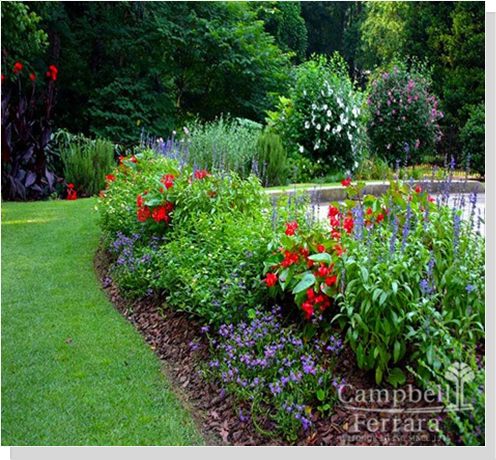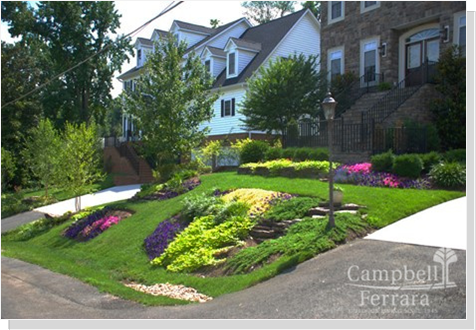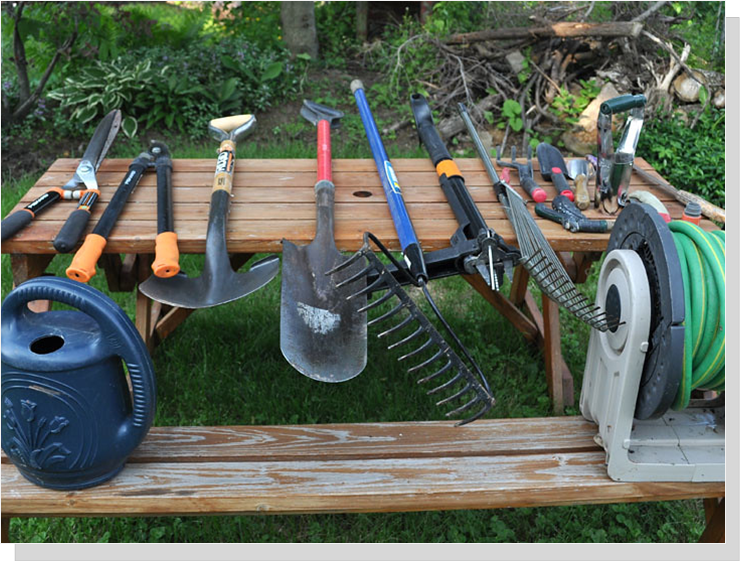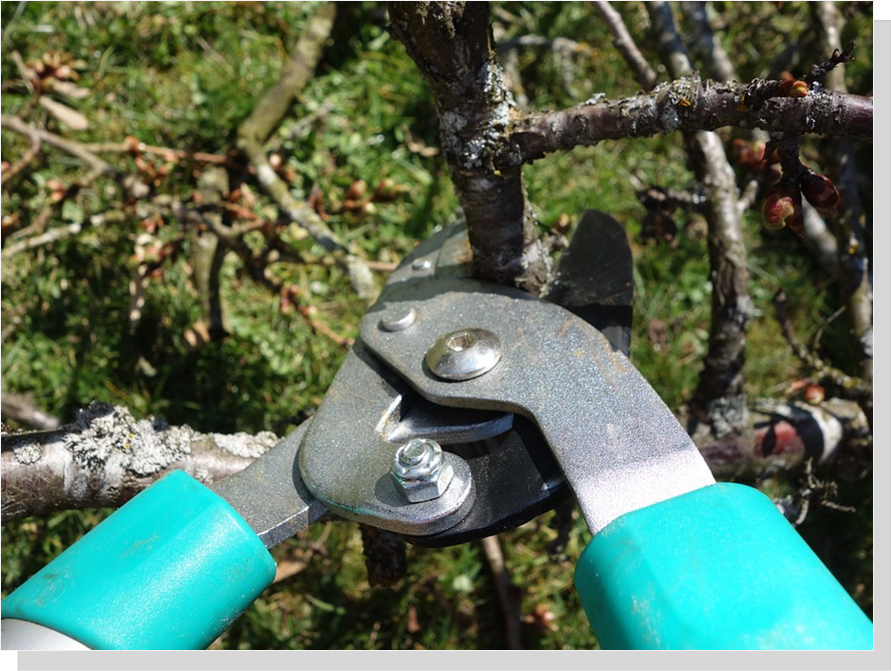
The Garden Path: Get Ready for Spring
Ten Tips for Preparing Your Garden
By: Miles Campbell
Campbell & Ferrara Outdoor Living
 Have you noticed any snowdrops, crocus, or other late winter plants popping their heads out of the ground?
Have you noticed any snowdrops, crocus, or other late winter plants popping their heads out of the ground?
If you have, you know spring is around the corner. And that means it’s time to prepare your garden for spring in Northern VA.
Spring Gardening Tips and Tricks to Start the Season on the Right Foot
After a long winter, it’s time to dust off your gardening tools and take inventory of your current beds. It’s also time to pull out the rakes to wake up your garden beds and your lawn.
Before spending time getting your gardening equipment and tools ready for spring planting, walk around your property with a notebook and pencil. Write down what perennials, shrubs, and trees are located in each landscaped area. Also, take stock of any seeds you saved in the fall.
You’ll also need a backyard design if you're starting new gardens. Sketch out some areas where garden beds would beautify your property. Consider how much light, wind, and drainage there are in each spot.
Make sure your new backyard design includes a mix of edibles and non-edibles. Flowers, fruit trees, vegetables, and shrubs don’t need separate beds. Instead, mingle them together for interest, texture, and color.
You may also want to hire a gardening service to help you with a backyard design and to suggest the best plants for your new garden.
Here are 10 spring gardening tips and tricks to start the growing season on the right foot:
Know your growing zone. Northern Virginia is in zone 7 according to the USDA Plant Hardiness Zone Map. Why do you need to know your plant hardiness zone? Because it helps you know when the last frost will occur and what plants can survive your summers.
For example, plant tags and seed packets that you buy at your local garden center will have zone plant hardiness listed on them. You can determine whether certain lettuces, marigolds, and pumpkins will grow well in Annandale, VA.
Inspect your gardening tools. You may store your gardening equipment in your shed or your garage. Spend some time cleaning up your pruning shears, tree lopper, rakes, shovels, and soil knives.
Check your inventory too. For example, do you have enough garden bed fertilizer? Do you need to buy compost or soil amendments? Do you need to add lime to your raised beds?
Make sure you sterilize your shovels, hoes, and soil knives if you picked up a pathogen last season. You don’t want to pass any plant diseases to your new gardens this spring.
Start seeds indoors. If you love thinking about preparing your garden for spring, then you may want to plant vegetables and flower seeds indoors. Go to your local garden center to purchase your seeds. There are also seed catalogs available, such as Burpee and Seed Savers.
Your garden center will also have Jiffy pots and other indoor seed starting products.
Gather your rakes and go to your garden beds. Use a lawn rake to gently remove the leaf litter and other debris from your flowerbeds. The smaller rake will allow you to move in-between plants to pull out the debris without taking any tender shoots with it.
Prune small trees and shrubs. Early spring is a great time to prune because trees and shrubs haven’t leafed out. So, you can see where you’re cutting and how that will affect the overall plant shape.
Concentrate on shrubs where the new blooms don’t depend on old wood (the wood from last season). Instead, you want to trim shrubs where the colors pop out from new growth. Here’s a small list of new wood, flowering shrubs:
- ¨ Butterfly bush
- ¨ Euonymus
- ¨ Panicle hydrangea
- ¨ Roses
- ¨ Rose of Sharon.
Prepare the soil in your garden. If you’re starting a new garden, you’ll need to remove the turf, do a soil test, and add soil amendments.
Once you’re done digging out the new garden beds, you’ll also have to till them with a rototiller. Then, you need to add any fertilizers to bring the soil back to health for growing new plants.
If you don’t own a rototiller or you can’t manage one, then call local gardeners near you. They can send out a crew to help you prepare a new garden bed for spring.
Don’t forget to divide your perennials. While you may have split hostas and daylilies in the fall, you may have other perennials in your backyard that need to be divided. For instance, divide Arkansas blue star amsonia, hellebores, ferns, brown-eyed Susans, and coneflowers in early spring.
While you’re dividing perennials in your gardens, take the time to start pulling weeds. The soft ground makes pulling out henbit, wild violet, hairy bittercress, and wild onion easy to do.
Plant summer bulbs and tubers. If you want a riot of color in your gardens this summer, then it’s time to plant lilies, including canna lilies, daylilies, Easter lilies, and resurrection flowers. Other perennials that grow from bulbs or tubers include:
- ¨ Caladium
- ¨ Crocosmia
- ¨ Dahlias
- ¨ Elephant ears
- ¨ Gladioli.
Early spring is a great time to plant ornamental trees and shrubs well before the summer starts in Northern Virginia.
All gardens need mulch. Bark mulches or pine needles add finishing touches to your spring garden. Mulch also regulates soil temperatures, holds in moisture, protects plant roots, reduces weeds, and provides nutrition as it breaks down during the growing season.
Practice self-care. Make sure that you stretch well before you start your spring garden preparation. Lower back muscles, hamstrings, and arm muscles get used when you garden, whether weeding, planting, or putting down mulch.
Also, protect your hands from thorns, briars, and dirt by wearing good-quality gardening gloves.
If Digging in the Dirt Isn’t Your Thing, Then You Need Garden Landscaping Near You. If you’re a busy two-career family, you don’t have time for gardening. Then, you need gardeners near you to design, prep the soil, and put in plants that will complement your property.
Contact us today at Campbell and Ferrara Outdoor Living to manage your gardens starting in the spring. We’ll prepare your gardens for spring by designing, prepping, and planting your new garden.
The ENDEAVOR News Magazine is pleased to introduce a new columnist, Miles Campbell of Campbell and Ferrara Outdoor Living and Landscaping who provide landscape design/build services and a retail garden center for Northern Virginia homeowners.
Reproduction of this story and photographs, in part or in whole, requires the written permission of the ENDEAVOR NEWS MAGAZINE. Copyright © 2011 Annandale Chamber of Commerce. All rights reserved.
(Photographs, on this page, and on this website, are the sole property of the Annandale Chamber of Commerce, and are not available for use by other publications, blogs, individuals, web or social media sites.
Gather your rakes and go to your garden beds. Use a lawn rake to gently remove the leaf litter and other debris from your flowerbeds. The smaller rake will allow you to move in-between plants to pull out the debris without taking any tender shoots with it.
Prune small trees and shrubs. Early spring is a great time to prune because trees and shrubs haven’t leafed out. So, you can see where you’re cutting and how that will affect the overall plant shape.

All gardens need mulch. Bark mulches or pine needles add finishing touches to your spring garden. Mulch also regulates soil temperatures, holds in moisture, protects plant roots, reduces weeds, and provides nutrition as it breaks down during the growing season.
Reproduction of this story and photographs, in part or in whole, requires the written permission of the The ENDEAVOR News Magazine. Copyright © 2011 Annandale Chamber of Commerce. All rights reserved.
(Photographs, on this page, and on this website, are the sole property of the Annandale Chamber of Commerce, and are not available for use by other publications, blogs, individuals, web or social media sites.)
Copyright 2012 Annandale Chamber of Commerce. All rights reserved. Privacy Policy


